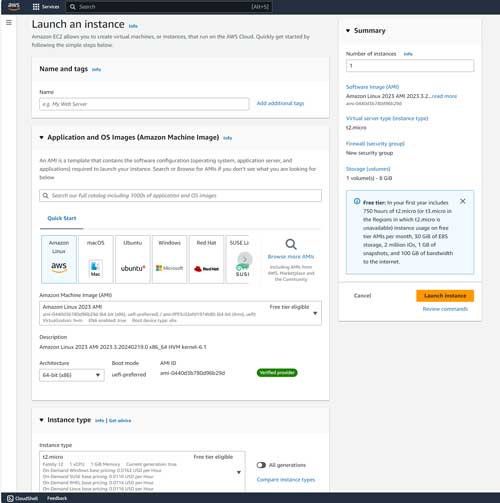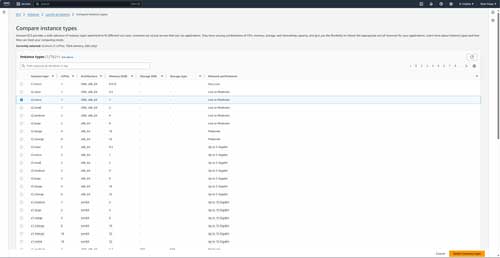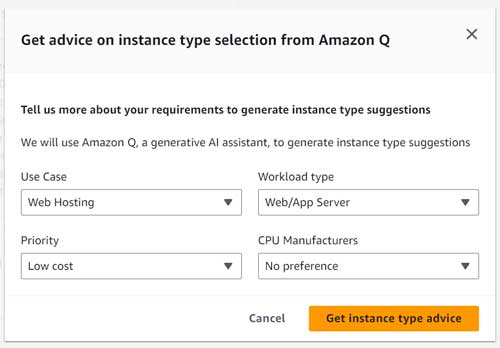AWS Step-by-Step
Selecting an Appropriate EC2 Instance Type, Part 2
Enter Amazon Q for some AI-powered selection assistance.
In Part 1, I explained that when you create a new EC2 instance, it's important to select the correct instance type. Choosing too small of an instance type will result in poor performance, while choosing too large of an instance type will result in unnecessary costs.
To date, the best way to choose an instance type was to select an instance type category that aligns to your workload, and then choose a specific instance type within that category based on the workload's hardware requirements. This strategy works well and it can still be used today. The downside, however, is that the codes that AWS uses to designate the various instance sizes are almost completely non-intuitive.
Recently, Amazon has released a new tool that makes the process of selecting an instance type far easier.
To try this new feature out for yourself, log into the AWS console and then open the EC2 dashboard. Next, click on the Launch Instance button. This takes you to the Launch an Instance screen, which you can see in Figure 1.
 [Click on image for larger view.] Figure 1. This is the screen used to deploy a new EC2 instance.
[Click on image for larger view.] Figure 1. This is the screen used to deploy a new EC2 instance.
As you look at the figure, you can see the Instance Type section at the bottom of the screen. AWS defaults to using a T2.Micro instance type, but there are hundreds of instance types to choose from.
Historically, the easiest way to narrow down the choice was to click the Compare Instance Types link. Doing so causes AWS to display the screen shown in Figure 2. This screen lists all of the different instance types along with their hardware configurations.
 [Click on image for larger view.]
Figure 2. The Compare Instance Types lists all of the available instance types.
[Click on image for larger view.]
Figure 2. The Compare Instance Types lists all of the available instance types.
Although the Compare Instance Types screen can be helpful, using it is not always practical. There are currently over 700 different instance types to choose from. Manually comparing all of those instance types probably isn't going to be an option. There is a search box that you can use, but using a search box requires you to have some idea of what you are looking for. As a side note, I also think that the Compare Instance Types screen would be more helpful if it listed pricing information for the various instance types.
So what about the new tool? Well, if you look back at Figure 1, you will notice that there is a Get Advice link located at the top of the Instance Type section. The Get Advice link is also present on the Compare Instance Types screen shown above. When you click on the Get Advice link, the console takes you to a tool that is powered by Amazon Q.
For those who might not be familiar with Q, it is Amazon's large language model, AI solution. Think of it as being similar to ChatGPT, but for the Amazon cloud. Like ChatGPT, you can build applications that are based on Amazon Q.
As you can see in Figure 3, the Get Advice tool is extremely simple to use. The tool consists of a graphical user interface and four drop-down lists.
 Figure 3. This is what the Get Advice tool looks like.
Figure 3. This is what the Get Advice tool looks like.
To use the tool, begin by choosing your use case. This means telling the tool what you are planning on using the instance for. For example, you might tell the tool that the instance is going to be used as a Web server, a gaming platform, or perhaps it might run CRM software.
Next, choose the workload type that will be used on the system. For example, if the instance is going to be hosting a database, then you would select the database type.
The third step is to specify your priorities for the instance. You might, for example, want to prioritize cost or performance. You could even tell the tool that you want to strike a balance between cost and performance.
Finally, you will need to tell the tool what type of CPU you want to use. You can choose between Gravitron, AMD, Intel and Apple.
When you have made your selections, just click the Get Instance Type Advice button. When you do, AWS will generate a block of text describing what you are trying to accomplish and will then send that text into Amazon Q. Amazon Q will then provide you with advice, as shown in Figure 4.
 [Click on image for larger view.]
Figure 4. Amazon Q provides advice on choosing an instance type.
[Click on image for larger view.]
Figure 4. Amazon Q provides advice on choosing an instance type.
About the Author
Brien Posey is a 22-time Microsoft MVP with decades of IT experience. As a freelance writer, Posey has written thousands of articles and contributed to several dozen books on a wide variety of IT topics. Prior to going freelance, Posey was a CIO for a national chain of hospitals and health care facilities. He has also served as a network administrator for some of the country's largest insurance companies and for the Department of Defense at Fort Knox. In addition to his continued work in IT, Posey has spent the last several years actively training as a commercial scientist-astronaut candidate in preparation to fly on a mission to study polar mesospheric clouds from space. You can follow his spaceflight training on his Web site.